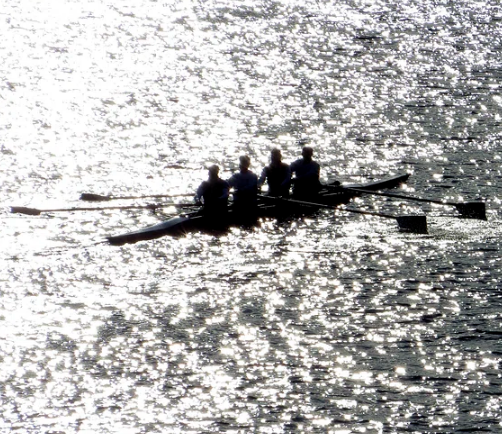
By Makerspace Team - IMU Makerspace
This is the first article in a series breaking down the process of generating metrics for cyclic sports using distinctive signal processing techniques. Here we look at the rowing stroke, and what metrics can be extracted from a combination of GPS and IMU data. The ADMOS sensor provides a single device with both IMU and GPS capabilities and is an ideal choice due to the small form-factor and high sampling frequency. Here, we detail how to provide a stroke-by-stroke analysis in rowing, providing more detail about the characteristics of the acceleration and velocity, and distance covered during each stroke than are usually available from either IMU or GPS sensors independently.
Updated Nov. 21, 2023, 5:38 p.m.Introduction
Many rowing coaches rely on measures of boat average velocity and strokes per minute to assess the performance of their athletes. While this can provide a rough estimate, a stroke-by-stroke analysis can provide more detail about the characteristics of the acceleration and velocity, and distance covered during each stroke.
This can help coaches to identify areas of the piece where athletes are meeting expectations and where there is room for improvement. Additionally, this detailed analysis is useful to identify characteristics associated with fatigue or incorrect phase transitions. This type of analysis relies on the utilization of a GPS sensor in conjunction with an inertial measurement unit. The ADMOS sensor provides a single device with these capabilities and is an ideal choice due to the small form-factor and high sampling frequency.
This article is an overview of a multi-part series breaking down the process of applying these sensor data to generate useful metrics. From acquisition, through data handling, signal processing and analysis.
Example Code
This series of articles are based on a single workflow, which has been implemented as a python notebook. You can find a link to this as a GitHub Gist, available below. These articles breakdown and describe elements of this workflow.
Workflow Breakdown
Acquisition and Initial Processing
This article lays the groundwork for future tutorials by showing how to load and do basic processing and visualization of our rowing data.
It also discusses the process of synchronization, but to assist with this, we have provided a breakout Article on this topic Sensor Data Synchronization in Rowing using Python.
Once the fundamental data has been acquired and synchronized, the next step is event detection. Within the rhythmic cadence of rowing lies a series of discrete events – with each stroke featuring a catch, and release tells a story of performance. Accurately identifying these moments facilitates a granular understanding of the rowing technique. In this section, we will explore the algorithms and methodologies employed to detect these events using the data provided by the ADMOS sensor. The precision and accuracy of this step directly influence the metrics derived, and hence, a comprehensive understanding of event detection is crucial for any coach or analyst aiming for an in-depth analysis of a crew's performance.
This process depends on a process called Wavelet Decomposition, for which we have created a breakout article, available here on how we implemented this process in our case.
With our data processed we move on to knowledge generation and translation. We discuss what metrics we can extract form the data we have gathered, and how we can provide a window on to a complex movement signal that visually describes what the athlete or crew was doing, and how they were performing.
Next Steps
Now that we have a foundation for understanding the use of sensor data in rowing analysis, highlighting the importance of detailed stroke analysis with the ADMOS sensor, we can move to the next article. Here we will focus on the practical application of these principles, exploring the first steps in the process - data acquisition and initial signal processing.
Next: Acquisition and Initial Processing